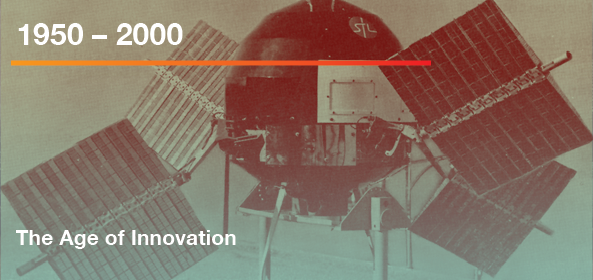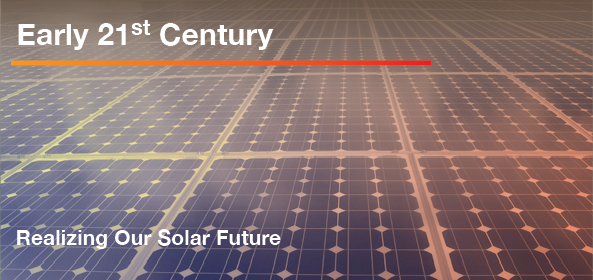History of Solar
The dawn of history brought with it the first use of solar power. As the centuries passed, people used the power of the sun in more creative and constructive—or destructive—ways.
Dawn of History – 1700s

600 B.C. The sun’s rays are concentrated through a magnifying glass to make fire.
200 B.C Greeks and Romans use sun-fi red mirrors to light torches.
100 B.C. Greek scientist Archimedes goes to war using bronze shields to focus sunlight and set Roman wooden ships on fi re.
300 B.C. Greek houses are built for passive solar heating and cooling.
1-400 A.D. Romans capture the sun’s energy for greenhouses and bath houses.
1200 A.D. Cliff-dwelling Anasazi Native Americans build homes to capture winter sun and summer shade in the Southwest.
Late 1700s-Early 1800s Tennessee Cherokees build houses for each season–smaller and circular house sunken into the ground for winter–rectangular houses made of wood and coated with earth and clay for summer.
19th and Early 20th Century

1800s Appalachian settlers build “dog trot” and “saddle bag” home designs for passive heating and cooling.
1839 French scientist Alexandre-Edmond Becquerel discovers the photovoltaic effect–the creation of electric current in a material exposed to light.
1870-1915 Cades Cove, Tennessee settlers build cantilever barns–-with passive heating and cooling.
1879 Electricity is first sold in the U.S. by the California Electric Light Company in San Franciso. The company produced and sold only enough electricity to power 21 electric lights.
1883 American scientist Charles Fritts harnesses the sun’s rays and creates the first solar cell.
1887 Serbian American inventor Nikola Tesla develops modern alternating current (AC) electrical supply system.
1891 Baltimore inventor Clarence Kemp patents the first commercial solar water heater.
1905 Albert Einstein publishes his paper on the photoelectric effect. The same year, he publishes his paper on the theory of relativity.
1918 Polish chemist Jan Czochralski invents the process to grow single crystals of silicon used in the production of semiconductor wafers used to make solar cells.
1920s-1950s Solar industry becomes a reality and grows until natural gas becomes the primary source for American homes.
1933 President Franklin Roosevelt signs the TVA Act. The Tennessee Valley Authority revitalizes the region, building hydroelectric dams to provide affordable electricity and continuing to draw industries to Tennessee and other South Eastern states.
1942 At the height of World War II TVA has 12 hydroelectric projects and a steam plant under construction and employs 28,000.
1947 Passive solar buildings help U.S. cope with WWII energy shortages.[/toggle_content]
1950s – 2000

1950s TVA becomes the nation’s largest electricity supplier.
1950s-1960s Solar power is launched in the U.S space program.
1954 Daryl Chapin, Calvin Fuller and Gerald Pearson develop the silicon photovoltaic cell at Bell Labs–the first solar cell that could use enough of the sun’s energy to power everyday electrical equipment.
1956 The first commercial solar cell is available to the public to power radios and toys. Cost is $300 per watt.
1958 Vanguard I satellite goes into earth orbit as the first to use solar-powered radio transmitters.
1959 Explorer VI is launched with four solar panel paddles, including 9,600 cells to recharge storage batteries while in orbit. Two months later Explorer VII goes into space – also powered by solar cells.
1960s TVA electric rates are some of the lowest in the nation.
1960s TVA starts building nuclear plants as another source of economical power for the region.
1964 The first of seven Nimbus weather satellites is launched, powered by a 470-watt photovoltaic array.
1966 NASA launches the first orbiting astronomical observatory, powered by a 1 kW photovoltaic array, to provide information about the ultraviolet and x-ray wavelengths filtered by the earth’s atmosphere.
1970s OPEC embargo causes oil shortages–and renewed public interest in solar energy.
1978 President Carter signs the Energy Tax Act that includes a tax for private residents and businesses who use solar, wind or geothermal sources of energy.
1982 Danish explorer Hans Tholstrup drives the first solar powered car, The Quiet Achiever, 2,800 miles across Australia in 20 days. Worldwide photovoltaic production exceeds 9.3 megawatts.
1983 Worldwide photovoltaic production exceeds 21.3 megawatts.
1993 Pacific Gas & Electric completes installation of the first grid-supported photovoltaic system in Kerman, California.
1998 TVA unveils a new clean-air strategy to reduce ozone and smog.
1999 The worldwide photovoltaic capacity reaches 1,000 megawatts.
1999 4 Times Square, the world’s tallest skyscraper (at the time)includes building-integrated photovoltaic panels that provide some of the building’s power.
2000 The TVA Green Power Switch® program begins on Earth Day. People and businesses can choose to purchase “green” energy from the companies that sell the power that TVA generates, and homeowners can buy Renewable Energy Credits.
Early 21st Century

2001 Helios, NASA’s solar powered aircraft, sets a new world record for non-rocket-powered aircraft at 18 miles high.
2001 Home Depot® begins selling residential solar power systems.
2002-2004 Oak Ridge National Laboratory and the U.S. Department of Energy build four near-zero-energy homes for Habitat for Humanity in Lenoir City, TN.
2003 TVA’s Generation Partners begins funding small- scale renewable energy projects.
2003 Sharp Corporation opens Memphis solar manufacturing plant.
2008 U.S. Department of Energy selects Knoxville to become a Solar America Cities partner to help accelerate the adoption of solar energy technologies.
2009 Governor Phil Bredesen signs Tennessee Clean Energy Future Act and launches the Volunteer State Solar Initiative, including the West Tennessee Solar Farm. The source of funding for the initiative is the American Recovery and Reinvestment Act of 2009. Funding of $625 million is distributed by the U.S. Department of Energy through a State energy Program grant to the Tennessee Department of Economic and Community Development.
2011 Hemlock Semiconductor Corporation builds Clarksville plant.
2009-2012University of Tennessee and Oak Ridge National Laboratory create the Tennessee Solar Institute, joining scientists, students, policy makers and industry partners for transformative change in solar energy production:
- More than 150 solar projects are funded across the state producing 6.5 megawatts of clean, renewable energy and $38.1 million in economic impact.
- 81 projects create a statewide economic impact of $26.1 million for companies in the Tennessee solar value chain.
- Trains dozens of Tennesseans in Solar Photovoltaic Installation courses and puts people to work in the clean-energy sector.
2010 Melton Hill Dam recreational area adds solar and wind power to create clean renewable energy. Charging stations for campers’ electric cars are also added.
2011 University of Tennessee students build the Living Light House for the Department of Energy’s Solar Decathlon in Washington, D.C.
2012 Wacker Chemie AG constructs a polysilicon production site.
2012 The West Tennessee Solar Farm goes on line as the largest utility-scale solar farm in the state.
